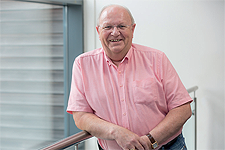Cutting edge
RAISING THE BAR FOR SAFETY AND PRODUCTIVITY. BY DAVID KENNEDY
It was one repair job with many challenges. All of them supersized. The external floating roof covered 4,000m2 – the same size as the pitch at Manchester United’s Old Trafford stadium.
It was also stuck at the bottom of the oil storage tank in Delta State, Nigeria. Oil residues and vapours in the tank presented a fire and explosion risk. But the tank’s owners wanted the defective roof removed. The solution was to harness the power of water.
A hydrodemolition team from a British water jetting specialist, a member of the Water Jetting Association (WJA), cut up the roof in just 17 weeks, ahead of schedule, with no incidents reported.
Key to their success was the use of abrasive ultra-high-pressure water jetting, combining water jets with additional cutting power provided by chips of garnet. First, a remote-controlled abrasive water jetting machine was used to cut an opening in the tank’s 35mm wall. The equipment was then used to slice the roof into 110 segments that were removed with a pick and carry crane. The removed tank section was replaced. Then a new roof could be fitted, returning the tank to service.
Vital maintenance tool
Water jetting in all forms has become an indispensable maintenance tool, not least in the energy and petrochemical industries. It is used for cleaning and de-fouling a huge range of equipment, including heat exchanger pipe bundles, process vessels, large-diameter pipes and, when they are not being cut up, storage tanks. It delivers excellent results, is sustainable, controls pollution, is safer than alternative mechanical systems, and has key advantages in hazardous environments.
As the UK’s trade association for water jetting, the WJA has been at the forefront of the industry’s development and celebrates its 40th anniversary in 2020. Members include water jetting contractors, manufacturers, equipment hirers, training providers, and businesses that use water jetting. International members are welcomed. The WJA’s codes of practice, developed over 40 years, are now widely recognised internationally as setting a trusted ‘gold standard’ for water jetting.
New medical guidelines
This is important because technical advances have extended the pressure range for water jetting, created new benefits and risks. In the 1970s, water jetting pressures of 340 bar or 5000 pounds per square inch (psi) were considered high. Now pressures exceed 2700 bar, or 40,000psi.
One of the biggest hazards is fluid injection injury, where water pierces the skin. This can happen at pressures as low as seven bar (100 psi). For this reason, in 2019, the WJA published new water jetting injury management guidelines. They are supported by an algorithm that details best practice actions at each step of medical response to injury, from giving first aid to ongoing hospital care. The guidelines are based on research commissioned by the WJA and published in the European Journal of Trauma and Emergency Surgery.
Research team leader intensive care specialist Dr Sancho Rodriguez-Villar, of Kings College Hospital, London, is clear about the guidelines’ importance. He says: “Without early and correct intervention, the outcome for those injured is often catastrophic, including death, loss of limbs and long-term disability. We strongly advise all parties involved to observe the WJA’s updated guidelines.”
Training advances
Training is also critical to water jetting safety. The WJA is the UK’s largest water jetting training provider and updates its courses in line with technical advances and new applications.
For 16 weeks, during the Covid-19 pandemic, the WJA suspended face to face training. It resumed on 1st July, with measures put in place to ensure training takes place in a Covid-19 secure environment.
WJA courses are accredited by City & Guilds and delivered in the UK and internationally by WJA-approved training companies and instructors. To obtain a WJA water jetting operative’s card and be registered on an international database, delegates must pass the one-day class-based Safety Awareness course and then at least one of four practical modules.
To maintain certification, operatives must attend a Safety Awareness refresher course every three years. The practical module must only be passed once. The WJA is also constantly adding to its training portfolio to improve water jetting standards and support best operational practice. New for 2020 are a Level 2 Diploma in competent water jetting and a water jetting management and leadership course.
Water jetting robots
WJA members are at the forefront of new technologies improving safety and productivity and extending the reach of water jetting into ever more challenging environments. Robotic water jetting, also known as semi-automated water jetting, can improve productivity and safety, by moving operatives away from water jets.
It is particularly important in the oil, gas and petrochemical industries for cleaning pipes and storage vessels. Water jetting with hand-held lances is a highly skilled process that can take years to fully learn. Robotic systems may allow contractors to jump a technology generation and benefit from automation.
However, operatives still need to be trained. They must understand the principles behind the behaviour and use of water at high and ultra-high pressures. Procedures for the safe use of these processes must be learned and applied.
 WATER JETTING ASSOCIATION
WATER JETTING ASSOCIATION
David Kennedy is Director of the Water Jetting Association (WJA). The WJA is the UK’s trade association for the water jetting industry and the biggest water jetting training provider. Members include service contractors, manufacturers, trainers and hire specialists. Its two codes of practice – for high-pressure and ultra-high-pressure water jetting and for water jetting in sewers – set internationally-recognized water jetting standards.
For further information please visit: https://waterjetting.org.uk